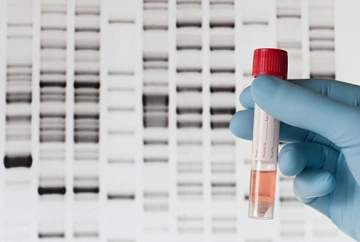Advances in Asthma Genetics Will Help Patients Breathe Easier
Most commonly, asthma manifests itself as having difficulty breathing, accompanied by any number of other symptoms, including, chest pain or tightness, anxiety, fast heart rate, cough, throat irritation and/or wheezing.


Roughly 90 percent of children with asthma have allergic asthma, which is triggered when they breathe in substances that set off an allergic reaction or experience drastic changes in their environment.
Most commonly, asthma manifests itself as having difficulty breathing, accompanied by any number of other symptoms, including, chest pain or tightness, anxiety, fast heart rate, cough, throat irritation and/or wheezing, a term used to describe the musical, high-pitched, whistling sound associated with air turbulence in the respiratory tract.
Asthma is a disease of special interest to Deb Meyers, PhD, co-director of the Division of Pharmacogenomics in the UAHS Center for Applied Genetics and Genomic Medicine and the co-chief of the Division of Genetics, Genomics and Precision Medicine in the UA Department of Medicine.

Asthma is a disease strongly influenced by both genetics and the environment. Deb Meyers, PhD, says research has found children who develop a specific type of asthma, called allergic asthma, often report a family history of asthma.
Dr. Myers has been a key player in the field of genetics for decades. From discovery of rare gene mutations that cause severe medical conditions to the application of new tools to better understand complex diseases, Dr. Meyers has helped us better understand the contributions of genes to human disease. In partnership with clinicians and patients throughout the world, Dr. Meyers also has applied this knowledge to help find new drug treatments for several medical conditions.
Roughly 90 percent of children with asthma have allergic asthma, which is triggered when they breathe in substances that set off an allergic reaction (allergens) or experience drastic changes in their environment. Allergens like dust, pollen, mold and pet dander cause a strong reaction in people with allergic asthma. Dr. Meyers works with groups across the nation to find genes that predispose children to develop allergic asthma.
While Dr. Meyers and her collaborators have been searching for asthma genes, the technology to identify genetic variation has evolved at a fast pace from the ability to look at a few specific locations in the human genome, to rapid sequencing of whole genomes. These incredible advances in technology have helped the field take huge leaps forward, Dr. Meyers says.

Allergens like dust, pollen, mold, and pet dander trigger a strong reaction in people with allergic asthma.
Access to data from whole-genome sequencing allows investigators to examine unknown genetic relationships that may be linked to disease.
By 2010, researchers found 12 individual locations in the genome that contribute to a person’s risk of getting asthma. Today, that number has grown to 129. A detailed description of these locations can be found in a resource called the GWAS Catalog.

By 2010, researchers found 12 individual locations in the genome that contribute to a person’s risk of getting asthma. Today, that number has grown to 129.
Biomarkers, are biological indicators of either effect, response or susceptibility that range from the detection of unique genetic variants in patients to blood tests that help track or predict a response to a medication. Under the umbrella of the PreCISE project, researchers like Dr. Meyers are hoping to use genetics and biomarkers to personalize treatment plans for individual patients suffering from asthma. This individualized approach to drug therapy, which in part relies on the use of genomic information, is called pharmacogenomics.
For additional information on pharmacogenomics at the UA, please go to http://precisionhealth.uahs.arizona.edu/.
About the Author
Valerie Schaibley, PhD is the Administrator for the Center for Applied Genetics and Genomic Medicine at the University of Arizona Health Sciences, where she works to advance precision health in the state of Arizona. She received her PhD in Human Genetics from the University of Michigan and worked for several years in industry, developing genetic tests for precision medicine applications.
About the Author
Kenneth S. Ramos, MD, PhD, PharmB, served as associate vice president for precision health sciences at the University of Arizona Health Sciences, director of the Center for Applied Genetics and Genomic Medicine and the MD-PhD Program, and professor of medicine. In 2019, Dr. Ramos accepted a position as executive director of the Institute of Biosciences and Technology in Houston and assistant vice chancellor for Health Services at The Texas A&M University System.
Dr. Ramos is a physician-scientist with interests in molecular and precision medicine, particularly as it relates to vascular pathology, oncology and chronic diseases of the lung. His translational research program integrates diverse approaches ranging from molecular genetics to population-based studies to elucidate genetic and genomic mechanisms of pathogenesis, and to develop novel approaches and therapies to minimize chronic diseases caused by environmental injury. Ongoing translational studies in his laboratory focus on the study of repetitive genetic elements in the mammalian genome and their role in genome plasticity, toxicity and disease, while clinical studies focus on the development and characterization of diagnostic and prognostic biomarkers of cancer and chronic pulmonary disease to advance the goals of personalized genomic medicine. He has directed two NIH P30 Centers of Excellence working at the interface between genomics and environmental health and medicine and have provided administrative and scientific leadership for two academic centers focusing on genetics and genomic medicine. He has influenced the career of many scientists through my involvement in several NIH-funded training and career development programs where he has mentored over 100 doctoral, medical, veterinary, undergraduate and high school students, many of whom have gone on to successful careers in academia, medicine, government and industry. He is deeply committed to initiatives that advance precision medicine and its applications to reduce disease burden and health disparities, improve quality of healthcare and reduce costs.

